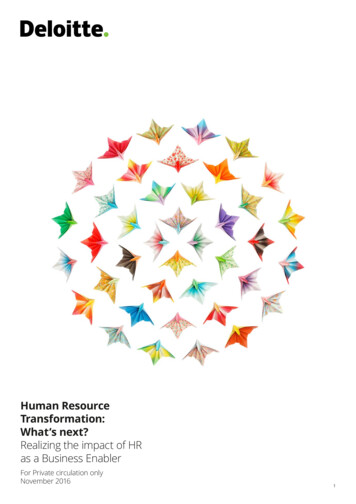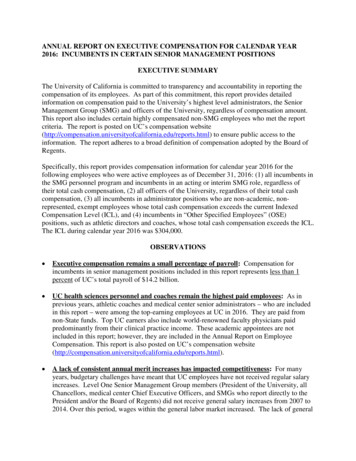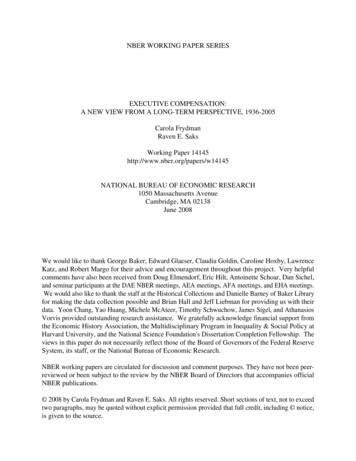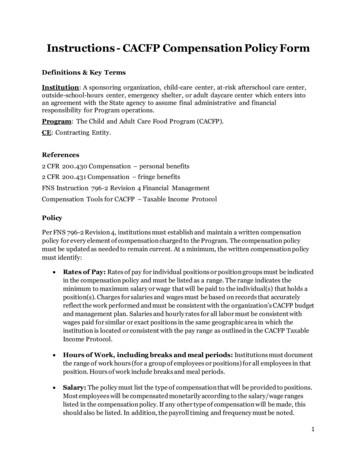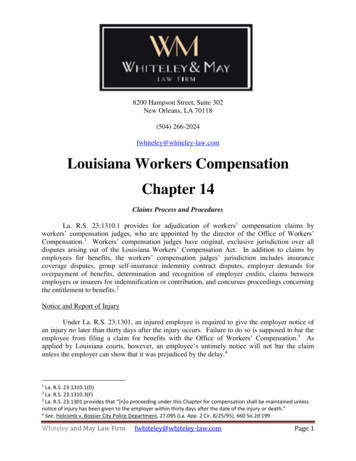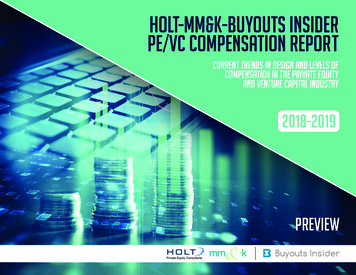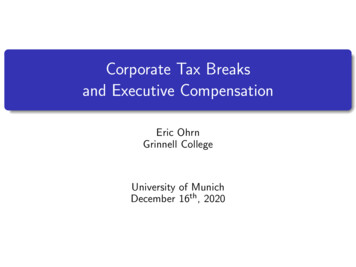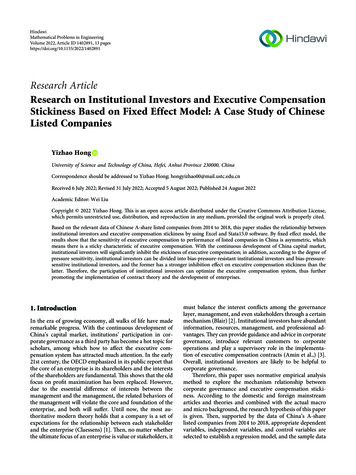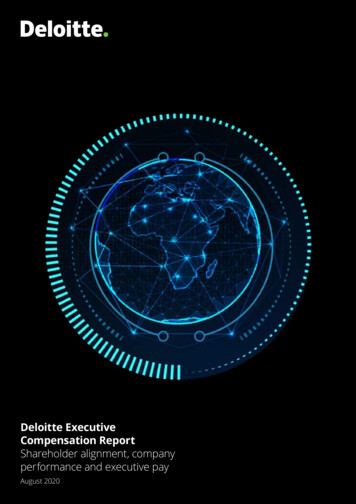
Transcription
Deloitte ExecutiveCompensation ReportShareholder alignment, companyperformance and executive payAugust 2020
ContentsPreface 11. Introduction 32. Headline findings662.1.Alignment of Executive Reward to Company Performance and Shareholder Value Creation2.2.Executive Remuneration as Disclosed 62.3.Performance Variable Pay 72.4.Shareholder Dialogue 72.5.Fair and Reasonable - a Single Figure Standard?73. Executive Compensation 2020: Current Issues 83.1.The Entrance of COVID-19 83.2.“Skin in the Game” 83.3.Is the System Broken? 83.4.What is Fair and Reasonable? 93.5.How Much is Enough? 94. Executive Compensation - 2019 Disclosure104.1.Introduction 104.2.Annual Pay Increases 104.3.The Scatter of Remuneration Levels 115. Executive Compensation by Size and Sector5.114Company Sizing for Benchmarking Purposes 145.2Remuneration Benchmark Levels by Company Size155.3Remuneration Benchmark Levels by Sector Grouping166. Performance / Value Alignment 186.1.Overall Contrasts in Return 186.2.Contrasts in Return by Company Size 196.3.Contrasts in Return by Sector 207. Performance Variable Pay217.1Introduction 217.2Pay Mix Standards 217.3Performance Variable Pay over the last Three Years8. Shareholder Dialogue21238.1.Shareholder Concerns 238.2.Shareholder Voting Trends 238.3.Shareholder and Proxy Advisor’s Views on COVID-19269. Towards a Single Figure Standard?27279.1.The Rationale for a Single Figure standard9.2.Developing a Single Figure standard 279.3.Flattening the Curve 2910.Executive Compensation under COVID-1910.1.31Background Implications of COVID-19 3110.2. Remuneration committees under COVID-19 3110.3. Remuneration Policy under COVID-19 3110.4. TGP (Guaranteed Pay) under COVID-19 3210.5. ACIs (Annual Cash Incentives) under COVID-193210.6. Share plan implementation during COVID-19 3411.Conclusion36Appendix 1 – JSE Listed Companies included in the Analysis38Appendix 2 – Short and Long-Term Incentive Design 43Appendix 3 – Useful Websites and References 45Appendix 4 – Table of Acronyms 46Appendix 5 – Organisation Grid Sizing 48
Deloitte Executive Compensation Report Shareholder alignment, company performance and executive payPrefaceWelcome to our fourth executivecompensation report. This report coversseveral topics, including multiple years’worth of executive remuneration disclosureand company performance data of the JSETop 250 companies.King IV and the requirements that itoutlines for executive pay continues tostoke divergent views, even as firms havehad a significant amount of time to digestthe governance code.The executive compensation debatehas recently taken a dramatic turn withthe arrival of the COVID-19 pandemic.COVID-19 is of significant concern to allstakeholders based on its immediate, andlasting impact, on society, the economy,businesses and employees.At this juncture, AGM’s are still taking place,and remuneration policies and practicesare still being disclosed and analysed bystakeholders. Disclosures overall pertain to2019, and the impact of COVID-19 could nothave been predicted, let alone reported on.can be assessed by stakeholders nexttime round, and in the light then of a moreinformed view of the pandemic and itsimplications.We aspire to offer a balanced overview ofthe recent past years to inform the debateon executive compensation in the light ofevents taking place this year.As we endure our current circumstancesand enter a very uncertain future, there isa demand to build an informed benchmarkof the recent past. This benchmark shouldhelp all stakeholders in the executiveremuneration debate, whether they be: Company executives who will recognisethat their circumstances and rewards willbe even more firmly under the spotlight. Consultants that take instruction fromthe company and their governancestructures. Remuneration Committees who will haveto re-imagine their remuneration policiesto respond to COVID-19.We trust that this report will be usefulin “benchmarking” current practice inexecutive compensation, while at the sametime predicting and to a certain extentreporting on the developments in 2020. Institutional shareholders whose role areoverseeing and influencing both policyand practice:– From their own and clients’perspectives, and– In terms of King IV , from a societalview.We hope that this report becomesthe template against which actualperformances and rewards for 2020(the first year under COVID-19) can becompared to those of pre COVID-19. The media and other commentators whoplay an essential role in exposing thegood, the bad and the ugly of executivepay.Implementation reports will contrast thecompany performance, executive rewardcharacteristics pre COVID-19 and during /resulting from COVID-19.Remuneration Policy disclosures shouldreport on the immediate measures takenby companies, and the longer-term revisedpolicies on executive compensation. Theefficacy and acceptability of policy revision Government and regulators who will feelthat executive compensation shouldbe reined in and societal disparitiesaddressed more systematically.The result of this review focuses inthe most part on the disclosure andgovernance linkages of executive pay. Weprovide a summary of current practicein the JSE listed companies and attemptto establish the broad linkages betweenshareholder value creation and companyperformance, in relation to executive payover eight years.Executive pay has been attracting intensemedia scrutiny both locally and abroad,with considerable focus on the debatearound the growing inequality betweenthose at the top of the organisation andthe general workforce. The entrance andimpact of COVID-19 will only exacerbateand bring more intensity to this debate.Foremost amongst the issues will be: King IV has engendered increasedlevels of dialogue between companiesand their shareholders. This disclosurehas primarily focused on the structure ofremuneration policies and the quality ofdisclosure in implementation reports. Remuneration Committees will haveto continue to focus on the targetsetting process to ensure targets areappropriately stretching and on thedisclosure of these targets in relation tothe pay-outs. The derivation of more straightforward,shareholder aligned, and societallyoriented structures. This was alwaysgoing to be the challenge for the future,and COVID-19 has accelerated thisrequirement.We believe that the Single Figure metric,as required by King IV , should be thebasis on which all companies positionthemselves. This approach will allow forobjective comparison while still ensuringflexibility in pay mix strategy.We have seen increased disclosure aroundmalus and clawback arrangements, whichshould address mal-performance and haulback executive pay where appropriate.Leslie YuillWorkforce Transformation LeaderDirectorDeloitte Consulting (Pty) Ltd01
Deloitte Executive Compensation Report Shareholder alignment, company performance and executive pay1. IntroductionThe last few years have continued to present anuncertain strategic and operating environment forcompanies. There were emerging signs of economic andfinancial rejuvenation, but the impact of COVID-19 hasdashed these hopes.More so than ever now, executive pay, likemany other business aspects, will challengecompanies, particularly in their pursuit of: Balancing and positioning, executiveperformance and reward in a changingeconomic environment. Reformulating the design andimplementation of pay deliverymechanisms. The demands placed on companies toconform to the principles and guidelinesof King IV in the stressful situationcreated by COVID-19. The increased requirement for firmsto do the “right thing” taking intoconsideration the broader socioeconomic impact of COVID-19.The disparity in levels of executive pay inrelation to those of the lower-paid workersis a societal concern worldwide. Thisdisparity is exacerbated in South Africa,with its additional transformational needsand high levels of unemployment. In a postCOVID-19 environment, the societal issueswill likely have a significant impact on thedirection of executive pay.Notwithstanding the above, most of thisreport confines itself to a qualitative andquantitative review of the nature anddisclosure of executive compensation. Wehave also commented on the likely impactof COVID-19. However, at this stage, itseffects and the actions of companies toaddress it are mostly unknown.The report updates the findings of theprevious report for the “Top 250” JSE listedcompanies, and the following issues areaddressed: An analysis of pay and particularlyperformance variable pay in thecontext of company performance andshareholder value over the last eightyears. The views and recent voting records ofinstitutional shareholders in overseeingexecutive compensation. An analysis of guaranteed pay,performance variable pay and totalannual pay and its growth over the lasteight years with a full examination of itsrelationship to company size and sectoralorientation. A discussion and summary analysisaround the debate, surfaced overseasand increasingly emerging here, aroundexecutive pay and shareholder alignment. The utilisation of a Single Figure approachto pay to assess pay differentials betweencompanies and within companies. What firms, and in particularRemuneration Committees, shouldconsider in their response to the currentpandemic, and the likely impact andconsequences to stakeholders given thevariability of outcomes.The analysis is based mainly on theinformation disclosed in the past Annual /Integrated Reports and financial accountsof companies in the JSE, as at endDecember 2019 reporting period.03
Deloitte Executive Compensation Report Shareholder alignment, company performance and executive payHow we can help you?The Deloitte executive compensationteam covers all aspects of executiveremuneration and share scheme designand advisory services.We can provide advice on all aspectsof executive remuneration, includingimplementation, investor relations,assurance, corporate governance,accounting, legal and tax issues.Our team includes remuneration, shareplan, tax and accounting specialists,governance experts and lawyers.Our integrated delivery modelDesign Reward strategy and pay mix Annual cash incentive design Long-term incentive plan design Share plan design Performance metrics andtarget setting Tax, legal and accounting advice Drafting of executive contracts andperformance agreements Employee share ownership schemes Executive “benchmarking” and sizingof executive roles using Execeval 04RemunerationCommittee advisoryImplementation andcommunication Drafting of remuneration reports Drafting of remuneration policies Drafting of charters Drafting of annual cash, long-termincentive and share plan rules Governance reviews and updates Executive pay “benchmarking” Key shareholder engagement aroundshare scheme implementations Updates on market trends, regulationand corporate governance JSE approvals Remuneration Committee Labs Drafting employee communications Tax assistance, global tax efficientarrangements, tax guides
Deloitte Executive Compensation Report Shareholder alignment, company performance and executive payContactsIf you would like further information onany of the areas covered in this report orassistance in interpreting and using thisdata, please do not hesitate to contact anyof the names below:Leslie YuillExecutive Compensation083 453 4242lyuill@deloitte.co.zaNita RanchodAccounting082 907 5999nranchod@deloitte.co.zaMark VictorGovernance082 772 3003mvictor@deloitte.co.zaDr. Candice AletterPolicies and Rules073 528 1022caletter@deloitte.co.zaAshleigh SadieIFRS 2 Valuations082 784 6394asadie@deloitte.co.zaNina le RicheGovernance082 331 4840nleriche@deloitte.co.zaTyrone JansenExecutive Compensation060 537 5873tyjansen@deloitte.co.zaMatt HartTax & Legal082 962 9823mathart@deloitte.co.zaMark HoffmanRemuneration Assurance082 496 3697marhoffman@deloitte.co.za05
Deloitte Executive Compensation Report Shareholder alignment, company performance and executive pay2. Headline FindingsThe following headline findings arise from this report:2.1. Alignment of ExecutiveReward to Company Performanceand Shareholder Value Creation Executive pay in larger companiescontinues to track the index ofshareholder value and top-lineperformance while still outstripping thatof bottom-line performance. In smaller companies, there is evidencecontrary to what one would expect. Manysmaller companies are paying as muchas, and often far more than much largercompanies. Within these overall patterns, one seesconsiderable variations in performancesby company size and by sector. It,however, appears that executive pay hasbeen resilient, more than doubling overthe period under review.2.2. Executive Remuneration asDisclosed Generally:– The very large, internationally footprinted, companies pay considerablymore than their local counterparts do,and– Again, the larger local companies paymore than the second-tier companies. Amongst the mid-tier companies anddescending into the lowest companies,there is an enormous “scatter” of pay.There is a weak link between executivepay and the size or the complexity of thecompany. If one looks at median pay by companysize grouping, one does see a trend,however, the dispersion (“scatter”) ofactuals either side of the median dispelsthe notion that companies are positioningthemselves relative to the median.06 Increases in guaranteed pay have slowedover the last year. Increases are closerto the inflation rate, demonstrating anincreasing constraint in the most visible,but not most impactful element of pay. The differential of the CEO pay above thatof the CFO remains significant. It confirmsthat commentators should be wary ofcondemning all executive pay policiesmerely on the trigger of the very visibleCEO pay. The inclusion of Prescribed Officers/advisory (third tier) executives indicates aless significant differential. There do appear to be some instanceswhere firms do not seem to be disclosingall remuneration. This could potentiallyrelate to the definition of PrescribedOfficers. In the case of large firms, it ishard to believe that there could only be2-3 Executives/Prescribed Officers in thegroup.2.3. Performance Variable Pay There are still only a few instances overan eight-year period where a CEO or CFOhas not earned a bonus. Although theoccurrence of share-based paymentsremains more sporadic, they are stilla significant contributor to the totalexecutive pay quantum. The dynamic of performance variable payhas changed somewhat with the onset ofCOVID-19. In the case of firms that have amid-year annual reporting cycle, we haveseen executives either giving up bonusesor not receiving one. A logical questionto be posed to those firms that paid orawarded incentives just before the crisisstarted is:– Could they/should they be doing morein this unique environment, especially ifthey now benefit from aid or are layingemployees off? The disclosure in Remuneration Reportson pay mix policy is still incomplete (albeitimproving with the requirement for SingleFigure reporting). In the larger companies, it appears thatthe pay mix for the top position(s) is atone-third (fixed pay) /two-thirds (variablepay) for target and as much as onequarter/three-quarters for maximumperformance. Generally, performance variable payappears to be performance contingentpay, accruing under most circumstancesother than the worst case of underperformance. This approach contrastswith performance-driven pay resultingfrom out-performance against targets setor in comparison to peer groups.2.4. Shareholder Dialogue There are now many well-constructedand informative Remuneration Reports,and in general, the disclosures on policyare increasingly consistent with King IV guidelines. In several cases, the essential elementsof executive pay practice are difficult todiscern as there is now almost too muchdetail in the Remuneration Reports toconsider. King IV stipulates that shareholdersshould engage with the companiesthat they are invested in on issuessurrounding not only shareholderalignment but also corporate citizenship.Shareholders are increasingly engagingwith Boards on the executive pay/performance/value relationships. In terms of corporate citizenship,shareholders, regardless of their stance,are perhaps less equipped to address theissue, given the more obvious COVID-19implications.
Deloitte Executive Compensation Report Shareholder alignment, company performance and executive pay2.5. Fair and Reasonable – aSingle Figure Standard? In our previous report, we advocated thatthe Single Figure required by King IV should not merely be a metric by whichannual pay comparisons are made. Ourview is that it should be utilised to:– Inform executive pay design,– Allow internal and externalcomparisons to pay, and– Inform the shareholder and societaldebates around what is “fair andreasonable” in executive pay. This approach will allow companiessome flexibility to differentiate theirexecutive reward strategies, as they areencouraged to do so in all other businessstrategies. At the same time, however,their pay strategies should be “governed”by and be accountable to acceptableparameters of executive pay. The Single Figure standard could bea way by which all stakeholders couldassess the full quantum of executive payover time, from whatever perspectivethey view it, whether internally, within thesector and now (very topically currentlyas a result of COVID-19) in relation tosocietal scrutiny.07
Deloitte Executive Compensation Report Shareholder alignment, company performance and executive pay3. Executive Compensation2020: Current IssuesIn our previous report, we raised and commented onseveral qualitative issues facing executive compensation.These same issues are summarised but not repeatedbelow. All of them will face intense scrutiny and debatein the next few years.This year the commentary focuses on theirrelevance in the face of the volatility andbearishness caused by COVID-19.3.1. The Entrance of COVID-19COVID-19 has become the major issueconfronting the world and its impact, inone way or another, will be long-lasting.Much will depend on how the pandemicdevelops, is countered and how we recoverfrom it. Currently, we all are concernedabout combating the short to mediumterm implications, while at the same timecontemplating what the longer-termconsequences might be.potential consequences in terms of localand global outcomes.3.2. “Skin in the Game”Shareholders generally hold that topexecutives should have “skin in the game”to demonstrate their alignment withshareholders with share ownership.We noted that this supposedly simpleconcept could be subject to nuances andopen to interpretation depending on thenature of the company/sector, the stanceof shareholders, and the stage of thecompany lifecycle.In the context of executive compensation,there is already evidence that companiesare making short-term adjustmentsto executive pay, on the basis that theeconomy will eventually recover. The onlyunknown is whether or not the “recovery”will be a “V style scenario” or a “U stylescenario” one in which the base of the “V” isprolonged.Whatever the Rationale for “skin in thegame” is, if the measure of “skin the game”is the value of shares that are held, whetherunencumbered or restricted, COVID-19 willlikely have diminished their value. Shouldthe volatility and bearishness causedby COVID-19 translate into a long-term,fundamental bear market, the effects couldbe far-reaching.Some commentators are, howeverpredicting that we are heading in thelong-term for an “L style scenario”, andthat life, society and capitalism will changefundamentally.Many companies have formal or informalpolicies as to the targeted/required valueof shares in relation to guaranteed pay.Any sustained fall in share prices will likelychallenge these policies.The decisions companies make aboutexecutive compensation in the short-termare unlikely to influence the “scenarios” butassist the companies in surviving whateverscenario unfolds. Companies should adopta scenario plan around their remunerationpolicies. Policies should address severalThe hold that restricted share ownershiphas on executives will diminish, and thealignment that unencumbered shareownership offers will reduce.08Companies may be tempted to offer moreshares due to their decreased value inrelation to pay. Policies will likely varydepending on the circumstances and thenature of the executive role in the postCOVID-19 situation. These could include: Professional executives continuing to actas custodians of shareholder value in“blue chip” value investments which havebeen dented but not destroyed by theCOVID-19 impact. Entrepreneurial executives spearheadingleveraged shareholder “private equity”investments to take advantage of newpost COVID-19 opportunities. Turnaround troubleshooters pickingup the pieces of COVID-19 “near-deathvalue destruction” and charged withresurrecting the floundering companyand bringing it back to life.3.3. Is the System Broken?Stakeholders are increasingly alleging thatexecutive compensation is too complicatedand needs to be: Simplified Subject to greater regulation More societally orientatedIn our previous report, we commented onthe difficulties in promoting, implementingand policing pay policies for executivesto satisfy the needs of shareholders,employees, society and regulators. Thisoften has to be done in a complicated,volatile, ill-informed and sometimes hostileenvironment.The main contributory factors have beenidentified in previous reports. They aresummarised and commented on in thecontext of COVID-19 below: Increased disclosure has resulted inthere being more information but lessinsight into the complexity of executivecompensation.
Deloitte Executive Compensation Report Shareholder alignment, company performance and executive pay Societal as much as shareholderdemands are placing RemunerationCommittees in a challenging andinvidious position. Advice to companies is reliant on surveysand ill-conceived benchmarks in somecases. The visibility of top executive pay to theexecutives themselves has enhancedthe demands of executives to be wellpositioned vis a vis their peers.is “fair and reasonable” in executive paycomes to the fore.We noted in previous reports that theanswer to the question would depend onwhether the issue is posed to: Well-paid executives, who already earnwell more than enough to provide fortheir family now and into the future andquite possibly the following generationsand are now striving to repair the damagecaused by the impact of COVID-19.a strong desire not only just to sellcolumn inches, but to expose perversity,corruption, and also the disparitybetween the “haves” and the “haves not”.Most stakeholders will concede thatexecutives should be paid well for theirservices to shareholders, to businessand the economy, and society as a whole.However, what is “fair and reasonable” inthe context of executive pay and moreimportantly, how should it be determined?The experience of COVID-19 will likelyprompt a re-evaluation of executive pay, interms of quantum and structure, and therewill inevitably be increased demands formore simplicity. Much will depend on theprogress of COVID-19 as much as its lastingcompact. The average person working hard toprovide for his family and frustrated atbeing unable to advance his position orhis pay, but thankful that he still has a joband perhaps appreciating (or not) that hisjob security is dependent on executiveretention and performance.There is increasing recognition, supportedby the principles of King IV that, total payrather than any one component of pay,should be used in assessing executive pay.Single Figure comparisons are now madewithin and between companies.There is evidence already that companiesare voluntarily cutting executive pay as agesture rather than for any permanentrecalibration in relation to the pay of theiremployees. The union representative striving toaddress the needs of his constituencyfor a fair wage, but mindful (or not) thatthe continued employment of the unionmembers is dependent on executiveretention and performance.If the Single Figure standard approachwere to provide a framework against whichstakeholders can recognise the acceptableparameters of overall executive pay, andlook to companies to adhere to them, whatthen would be “fair and reasonable”? The large number of semi-employedindividuals living on or about the breadline who barely survived the economicimpact of Covd19.3.5. How Much is Enough?In chapter 9, we comment on the SingleFigure Standard that we advocate, and howit progresses from the lowest-paid workersthrough to the top executives of the topcompanies that employ these workers.A curve is shown that brings under thespotlight the increasing disparity as oneproceeds along the curve from lowestto highest-paid. Countries have adoptedpolicies of late to “flatten the curve” withrespect to COVID-19. It may be that whenthe COVID-19 nightmare is over, thesesame countries may take the concept of“flattening the curve” on board and apply itto executive pay.3.4. What is Fair and Reasonable?In the light of the comment on “flatteningthe curve”, the debate currently on what The unemployed (both young andold) who barely get by from day today supporting themselves and theirextended families and took a heavy tolland barely survived COVID-19. The politicians often deeply concernedabout the disparities between theprivileged and underprivileged andunemployed. However, also, some ofthem, recognising that it is the growth incommerce and industry that will enhancethe economy and lead the majority awayfrom current penury and into futureposterity.We noted in a previous report that“executive leadership” is generally regardedas a scarce commodity and one for whicha premium should be paid. Those thathave gleaned this commodity througheducation, experience, innate skills, ora combination of all of these, generallyfeel that they should be appropriatelyrewarded. If nothing else so that they canlive to a certain standard and prepare forthe continuation of this standard into theirretirement from active service.Post COVID-19 it will not be surprisingif there is a general call amongststakeholders that “enough is enough”. The columnists, from all sides of thepolitical spectrum, many of them having09
Deloitte Executive Compensation Report Shareholder alignment, company performance and executive pay4. Executive Compensation– 2019 Disclosure4.1. IntroductionThe analysis that follows is based on a complete survey of disclosed pay amongst JSE listedcompanies and has confirmed several of the trends identified in our previous reports.4.2. Annual Pay IncreasesTGP: Total guaranteed pay Basesalary plus allowances & companymedical and / or retirement funding.TAC: Total annual compensation TGP plus cash bonus.The tables below depict the growth in both TGP, TAC and TR over the last six years and theprevious three years, respectively.TR: Total remuneration TAC plusvested value in year from any longterm (share based) incentive.Schematic 1: Growth in TGP, TAC and TR over six years6 Year Compound Annual Growth Rate (CAGR)Median Growth in TGP, TAC and TR over six yearsMedian Growth in TGP, TAC and TR over six years8%8%6%6%4%4%2%2%0%TOPLARGETGP 50thMEDIUMTAC 50thSMALL0%CBTR 50thFSITGP 50thIMTAC 50thE&RTR 50thSchematic 2: Growth in TGP, TAC and TR over three years3 Year Compound Annual Growth Rate (CAGR)Median Growth in TGP, TAC and TR over three years8%8%4%6%0%4%-4%-8%2%TOPLARGETGP 50thMEDIUMTAC 50thSMALL0%TR 50thIn previous reports, we commented on theoccurrence of above-inflation growth over five years,and over three years.However, current growth over six years and themost recent three-year growth is more in line withinflation. This indicates that in the last two to threeyears, as one might expect, growth in executive pay ismore attuned to the market as well as economic andgovernance pressures.10Median Growth in TGP, TAC and TR over three years10%CBFSITGP 50thIMTAC 50thE&RTR 50thCB: Broad sectoral grouping of consumer business companies,including technology companies.FSI: Broad sectoral grouping of financial and propertyinvestment holding companies.IM: Broad sectoral grouping of industrial and manufacturingcompanies.E&R: Broad sectoral grouping of mining & resources andconstruction companies.
Deloitte Executive Compensation Report Shareholder alignment, company performance and executive payHowever, the question should be asked:Why do executives get a similarincrease to rank and file staff inrelative terms, when 5 – 6% of a largenumber produces a vastly differentoutcome to a 5 – 6% increase on asmall amount?Often, we have seen very littledifferentiation of relative increasesbetween executive officers and generalstaff.4.3. The Scatter of RemunerationLevelsMost commentators support a view thatexecutive pay should reflect the size andcomplexity of the executive role. As thisreport comments on the CEO, CFO andPrescribed Officer positions, it is fair toassume that it is the size of the companyand (perhaps) the operational/financialcomplexity of the sector in which itoperates that defines the role.Below are a series of scatter diagramsthat show the CEO, CFO and PrescribedOfficer remuneration (TGP, TAC and TR) bycompany size (three-year average of marketcapitalisation R billions).Schematic 3: CEO remuneration “scatter” by company size50202040302010TGP ( R million)25TGP ( R million)TGP ( R 3040050075010001250504040302010201010203040050CEO TR vs 3 year ave Mkt CapCEO TR vs 3 year a
Compensation Report Shareholder alignment, company performance and executive pay August 2020. Contents Preface 1 1. Introduction 3 e n i l d a e H . 2 s g n i d n fi 6 2.1. Alignment of Executive Reward to Company Performance and Shareholder Value Creation 6 2.2.Executive Remuneration as .

